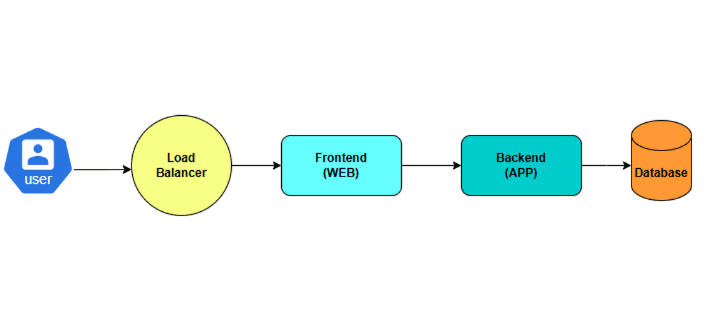When you log into a website, several layers work together to process your login details and keep your information secure. This is made possible by a system known as 3-tier architecture, which organizes the application into three distinct layers. Each layer handles a specific part of the process, making the system more efficient and secure.
What is 3-Tier Architecture?
In basic terms, 3-tier architecture splits an application into three separate layers:
- Frontend (Web Tier) – The user interface you interact with.
- Backend (Application Tier) – The processing center that handles your requests.
- Database (Data Tier) – Where all the data is stored.
Each layer has its own role, helping keep the system organized, secure, and easy to manage.

How Does 3-Tier Architecture Work?
Let’s use a common example: logging into a website.
1. Frontend (Web Tier): This is the static layer you interact with. When you enter your username and password on a login page, you’re interacting with the frontend. Technologies like HTML, CSS, JavaScript, and frameworks like ReactJS or AngularJS power this layer. Once you fill in your details and hit submit, the frontend sends the data to the backend for further processing.
2. Backend (Application Tier): This dynamic layer handles the processing of your requests. The backend (also known as the application server) receives your login details, checks them against the database, and processes the result. Technologies like Java, Python, or .NET are commonly used here, and application servers like Tomcat or JBoss help run these backend apps. The backend checks if the username and password match what’s stored in the database dynamically and sends a response back to the frontend.
3. Database (Data Tier): This is where all the important data is kept. When logging in, the database contains a table with your username and password. Common databases include MySQL, PostgreSQL, MongoDB, and others.
The backend queries the database to see if the login information is correct. If it is, you’ll be logged in; if not, you’ll see an error message.
In a 3-tier architecture, a reverse proxy can be added in front of the application layer to enhance security, balance traffic, and manage SSL, but it’s not a strict requirement.
Why Separate the Frontend, Backend, and Database?
Now, you might wonder why we need to split the application into three layers. Why not just combine everything into one?
Here’s why 3-tier architecture is a better approach:
- Improved Organization: Each layer has a dedicated function. The frontend focuses on user interaction, the backend handles processing, and the database stores data. This makes the system easier to maintain and update.
- Better Security: By separating the backend from the frontend, we ensure that the frontend doesn’t directly access the database. This reduces the risk of exposing sensitive information, making the application more secure.
- Scalability and Load Balancing: With 3-tier architecture, you can use a load balancer to distribute requests efficiently. If one server is busy, the load balancer can direct traffic to another, ensuring smooth performance even during high traffic.
- Crash Prevention: If the backend and database are on separate servers, a crash in one layer won’t affect the other. For example, if the application goes down, the database remains safe and unaffected.
What Happens Without 3-Tier Architecture?
Let’s consider some of the challenges with not using 3-tier architecture:
- Complex Queue Management: Handling multiple requests simultaneously can slow down the system, causing delays and potential crashes.
- Increased Burden: If the frontend and backend are combined, the system can struggle to manage tasks efficiently. Imagine a lot of users trying to log in at once: this can overwhelm the system.
- Poor Security: When the frontend accesses the database directly, it exposes the application to potential security risks, making sensitive data vulnerable to hacking.
How 3-Tier Architecture Works in Action
Here’s a simplified example of how it works:
- You enter your username and password in the frontend (e.g., a ReactJS login form).
- The frontend sends this information to the backend (e.g., a Java application).
- The backend runs a query on the database (e.g., MySQL) to check if the username and password are correct.
- If the details match, the backend tells the frontend to log you in. If not, it sends back an error message.
To dive deeper… Check out these related topics:

